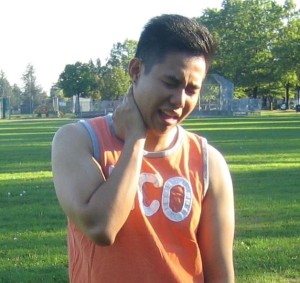It is important to note that muscle spasms are best described as involuntary muscular contractions. They are considered as the usual components of neck pain and injuries. In most cases, the muscle spasms are simply minor annoyances that improve quickly on their own or with conservative treatments. Oftentimes, the neck muscle spasms can indicate a serious underlying condition. Take note that a muscle spasm can be treated by applying an ice or heat pack, exercising the affected muscle and stretching.
Muscle strain
A muscle strain can occur once a muscle is overly stretched in an abrupt or traumatic manner. This leads to the tearing of the muscle fibers and can range from minor micro tearing to a full rupture of the muscle. Take note that muscle strains commonly occur during vehicular accidents, slip and fall injuries and sports injuries. Once the muscles are strained, the affected area becomes inflamed and can lead to muscle spasms, bruising and localized pain. Most cases of muscle strains resolve with the help of ice, non-steroidal anti-inflammatory drugs (NSAIDs) such as naproxen, ibuprofen and aspirin and even physical therapy. If you want to learn more about these measures, click here.

Posture
If the individual has poor posture, it can cause neck pain along with muscle spasms. This can be due to an overuse injury in which the muscles in the neck are strained for an extended period of time by the poor posture.
Arthritis
Arthritis basically involves inflammation of the joint. Osteoarthritis is a condition triggered by wear and tear of the cartilage and joints. Once this form of arthritis progresses, it can lead to damage to the surrounding soft tissues including the muscles and nerves. This will lead to muscle spasms in various muscles surrounding the cervical spine. In some cases, the condition can lead to the development of bone spurs or even the collapse of the joint which can add pressure on the neighboring spinal nerves. As a result, symptoms such as muscle weakness, pain, numbness, muscle spasm and tingling can occur.
Herniated disc
The cervical spine is composed of bones called the vertebrae which are separated by spongy discs. Take note that the spinal disc is structured to absorb shock but over time or injuries, it can deteriorate, herniate or bulge into the spinal canal. Once this occurs, the disc material will only add pressure straight on the spinal cord or the subtle spinal nerves that branch off the cord at every vertebral level. A herniated disc that adds pressure on a nerve will cause localized and radiating pain that can travel to the shoulder, down the arms and up to the fingers. Additionally, it can also cause tingling, numbness, muscle spasms in the neck and muscle weakness. Most cases of herniated disc can respond well to conservative measures and do not need surgical intervention.
